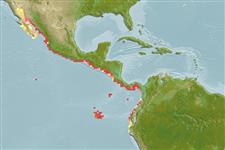>
Carangaria/misc (Various families in series Carangaria) >
Polynemidae (Threadfins)
Etymology: Polydactylus: Greek, poly = a lot of + greek, daktylos = finger (Ref. 45335).
More on author: Gill.
Environment: milieu / climate zone / depth range / distribution range
Ecologia
marinhas demersal; intervalo de profundidade 10 - 60 m (Ref. 91172). Subtropical; 34°N - 7°S, 118°W - 77°W (Ref. 57343)
Eastern Pacific: Los Angeles Harbor in California, USA to off Paita, Peru; rare north of Baja California, Mexico.
Tamanho / Peso / Idade
Maturity: Lm ? range ? - ? cm
Max length : 50.0 cm TL macho/indeterminado; (Ref. 55763); common length : 25.0 cm TL macho/indeterminado; (Ref. 55763)
Espinhos dorsais (total): 9; Raios dorsais (total): 11-13; Espinhos anais 3; Raios anais : 12 - 14. Body and fins yellowish; no stripes or spots. Anterior parts of lower jaw with villiform teeth extending onto lateral surface, adjacent part of lip poorly developed in large specimens. Vomerine teeth present. Maxilla covered with small deciduous scales. Pectoral filaments 9. Lateral line unbranched, extending to upper end of caudal fin lobe. Swim bladder absent (Ref. 45049).
Inhabits coastal waters and estuaries, on sand and mud bottom (Ref. 9332). Also found along sandy beaches (Ref. 57343). Esteemed food fish in the tropical eastern Pacific (Ref. 57343).
Ciclo de vida ou comportamento de acasalamento
Maturidade | Reprodução | Desova | Ovos | Fecundidade | Larvas
Motomura, H., S. Kimura and Y. Iwatsuki, 2002. Revision of the threadfin genus Polydactylus (Perciformes, Polynemidae) from the eastern Pacific Ocean. Ichthyol. Res. 49(4):358-366. (Ref. 45049)
Status na Lista Vermelha da UICN (Ref. 130435)
Ameaça para os humanos
Harmless
Uso pelos humanos
Pescarias: pouco comercial
Mais informação
ReferênciasAquaculturaPerfil para aquaculturaEstirpesGenéticaElectrophoresesHereditariedadeDoençasProcessamentoNutrientsConversão de massa
ColaboradoresFotosStamps, Coins Misc.SonsCiguateraVelocidadeTipo de nataçãoÁrea branquialOtólitosCérebrosVisão
Ferramentas
Relatórios especiais
Baixar XML
Fontes da internet
Estimates based on models
Preferred temperature (Ref.
123201): 24.6 - 28.6, mean 27.2 °C (based on 32 cells).
Índice de diversidade filogenética (Ref.
82804): PD
50 = 0.5000 [Uniqueness, from 0.5 = low to 2.0 = high].
Bayesian length-weight: a=0.00661 (0.00383 - 0.01141), b=3.07 (2.92 - 3.22), in cm total length, based on LWR estimates for this species & Genus-body shape (Ref.
93245).
Nível Trófico (Ref.
69278): 3.3 ±0.51 se; based on food items.
Resiliência (Ref.
120179): Elevada, tempo mínimo de duplicação da população menor que 15 meses (Preliminary K or Fecundity.).
Fishing Vulnerability (Ref.
59153): Moderate vulnerability (40 of 100).
